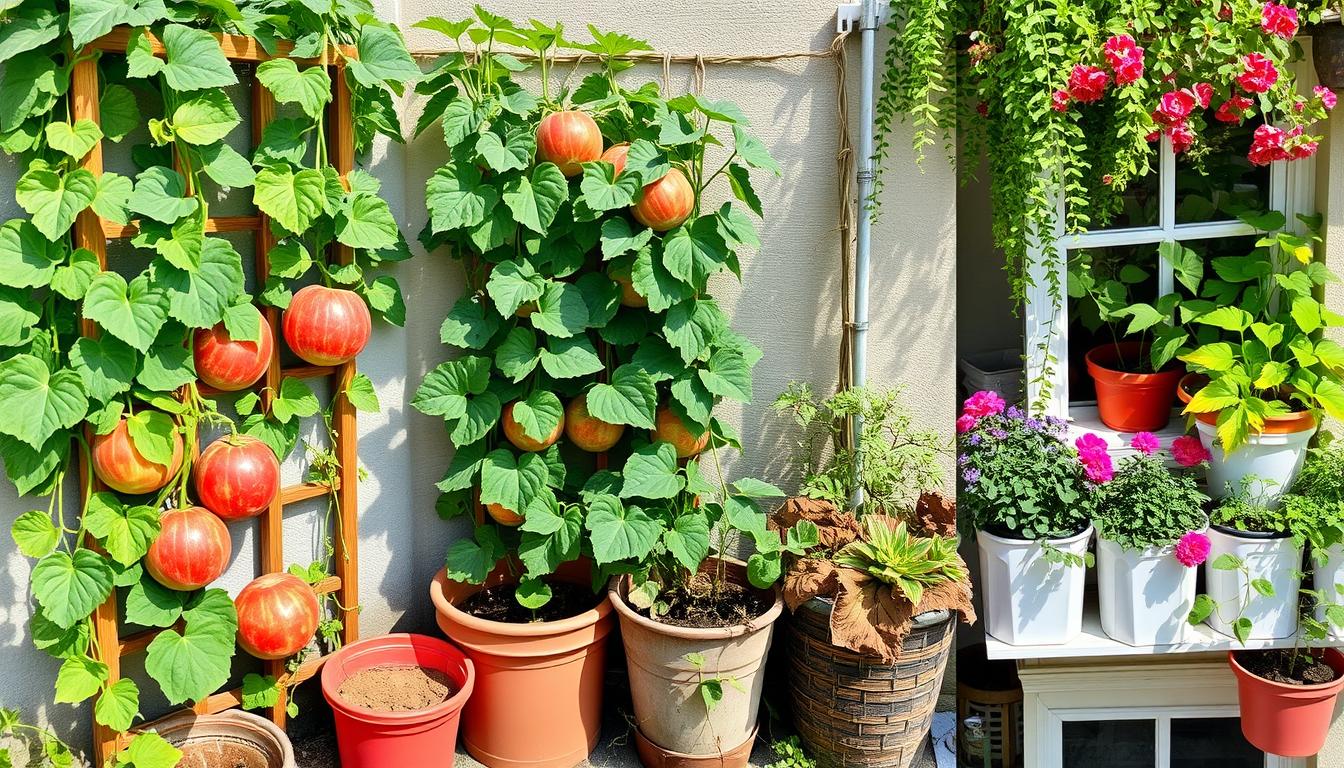Growing watermelons in small spaces might seem hard, but it’s doable. This guide will show you how to grow watermelon in tight spots. We’ll focus on green ways and smart use of your space.
Even with a tiny patio or balcony, you can grow delicious watermelons. We’ll look at the best watermelon types for small areas. Plus, we’ll share growing tips and how to keep your plants healthy.
Key Takeaways
- Choose compact varieties like Sugar Baby for limited space.
- Containers for planting should be at least 18 inches deep.
- Trellising is an effective method for growing watermelons vertically.
- Support heavy fruits with slings to avoid stem damage.
- Ensure your watermelon plants receive at least 8 hours of sunlight daily.
Understanding Watermelon Varieties for Small Spaces
Choosing the right watermelon variety is key for growing in small spaces. There are many varieties, but some are better for small gardens. These varieties fit small spaces and grow delicious fruits.
Choosing Compact Varieties
Compact watermelon varieties are great for small gardens. Look for varieties with short vines and small fruits. They grow well in small areas and are ready to harvest quickly.
Best Choices: Sugar Baby, Golden Midget, and Early Moonbeam
For my garden, I choose Sugar Baby, Golden Midget, and Early Moonbeam. Each variety is special:
- Sugar Baby: It has a sweet taste and round shape, perfect for small gardens.
- Golden Midget: It grows small, sweet fruits and matures fast, ideal for small gardens.
- Early Moonbeam: It has a unique taste and grows well in small spaces.
Growth Characteristics and Suitability for Trellising
It’s important to know how these varieties grow. They have short vines and mature quickly, in 75 to 90 days. Trellising helps save space by growing vines up. These varieties work well with vertical gardening, making small areas more productive. For more tips, check out Garden Beginner.
How to Grow Watermelon in Small Spaces
Growing watermelon in small spaces can be rewarding. Containers are a great way to grow watermelons in tight spots. With the right steps, anyone can grow watermelons in a small garden or on a balcony.
Using Containers Effectively
Container gardening is flexible and creative. A container at least 18 inches deep is key for healthy roots. Sizes from 15-gallon to 20-gallon are best for growing compact varieties like Sugar Baby and Golden Midget.
Choose containers with good drainage. I use potting mix with compost and organic fertilizer. Keeping an eye on soil moisture and fertility is crucial for success.
Depth Requirements and Container Sizes
The right container size is vital for growth. A container at least 18 inches in diameter boosts fruit production chances. Ideal setups include:
| Container Size | Depth (inches) | Soil Volume (gallons) | Recommended Varieties |
|---|---|---|---|
| 15x15x15 inches | 15 | 9.5 | Sugar Baby, Golden Midget |
| 18x18x18 inches | 18 | 13.5 | Early Moonbeam, Blacktail Mountain |
| 20x20x18 inches | 18 | 18 | Any compact variety |
Before growing watermelons, consider soil temperature, sunlight, and the need for a trellis. Knowing these factors makes growing watermelons in small spaces rewarding and fun.
Maximizing Vertical Space with Trellises
Using trellises for growing watermelons in small spaces is a smart move. It turns tiny areas into green oases and helps plants grow better. I’ll show you how to build a strong trellis, train vines, and use slings for fruit support.
Building a Sturdy Trellis
Choosing strong materials is key for a trellis that can hold heavy watermelons. A good trellis supports vertical growth and makes small gardens look better. Look into designs like tripods or arbors for support and more space for other plants.
Training Vines Upwards for Optimal Growth
Training vines up the trellis is important. It improves air flow, sun exposure, and can increase yields. This method is great for small gardens, making the most of limited space. Keep an eye on the vines to avoid tangling or breaking.
Supporting Watermelon Fruit with Slings
Slings are essential for supporting watermelon fruit as it grows. They keep the fruit off the trellis and prevent stem damage. This method keeps the fruit safe from pests and diseases, leading to a better harvest.

These methods improve space use, plant health, and productivity in urban watermelon growing. For more on affiliate programs and integrity, check out this resource.
Preparing the Growing Environment
Creating the right conditions is key for growing watermelons in the city. A few important factors can greatly affect their growth and yield. This is especially true for small area watermelon farming.
Importance of Full Sunlight
Watermelons love full sunlight and need at least 8 hours of direct light daily. Without enough sunlight, they grow slowly and ripen late. Make sure to place your plants in a spot that gets plenty of sunlight for the best growth and fruit.
Ideal Soil Conditions and Depth
Watermelons do best in sandy loam that’s rich in organic matter and drains well. Good drainage stops root rot, keeping plants healthy. The soil should be at least 12 inches deep to support the watermelon’s deep roots.
This depth helps with nutrient absorption, boosting harvest yields. For more tips on growing watermelons, check this resource.
Watermelon Growing Tips for Gardeners with Limited Space
For gardeners with little space, growing watermelons requires careful timing and watering. Knowing these tips can make gardening more enjoyable. Here are key tips for growing watermelons in small spaces.
Planting Timing and Soil Temperature
Planting watermelons at the right time is crucial. Wait until the soil is at least 70°F (21°C). This helps them grow well from the start.
In warm places, you can start planting in mid to late March. In cooler areas, wait until mid-April for better results.
Watering Techniques for Healthy Vines
Watering your watermelon vines right is key, especially in small spaces. Water deeply once or twice a week to build strong roots. Light watering too often can stress them out.
Check the soil moisture often, especially when it’s hot. Melons need steady moisture to avoid problems like blossom end rot.
By following these tips, you can enjoy growing watermelons, even in small spaces. Use the right planting time and watering methods for sweet, juicy melons.
Companion Planting for Small Area Watermelon Farming
Using small garden watermelon tips like companion planting can really help your watermelons grow. Pairing watermelons with the right plants not only boosts growth but also fights pests. This makes for a healthy and thriving garden.
Best Companion Plants for Watermelon
It’s important to choose the right friends for your watermelon plants. Here are some top picks:
- Corn: Acts as a natural trellis and provides shade.
- Basil: Repels pests like aphids and attracts pollinators.
- Marigolds: Deters nematodes and several insect pests.
- Lettuce: Grows quickly and prevents weed growth.
- Beans: Adds nitrogen to the soil, enhancing growth.
- Dill: Attracts beneficial insects such as ladybugs, which prey on pests.
- Garlic: Offers antifungal qualities and pest repellent properties.
- Mint: Strong aroma repels aphids and flea beetles.
- Nasturtium: Serves as a trap crop for pests while attracting beneficial insects.
Avoiding Plant Interference and Competition
Companion planting is great, but you must think about which plants get along. Some plants might take over and steal nutrients and water. For example, avoid planting watermelons near cucumbers and squash because they attract the same pests.
Instead, use plants like clover to improve soil and reduce weeds. This keeps your watermelons the main attraction in your garden.
| Companion Plant | Benefit |
|---|---|
| Corn | Natural trellis and shade |
| Basil | Pest repellent and pollinator attraction |
| Marigolds | Insect deterrent |
| Lettuce | Weed prevention |
| Beans | Nitrogen fixing |
| Dill | Attracts beneficial insects |
| Garlic | Pest control |
| Mint | Aphid repellent |
| Nasturtium | Trap crop for pests |

Cultivating Urban Watermelon Gardens
Urban watermelon cultivation is rewarding with the right gardening techniques. DIY self-watering containers keep the soil moist, which is key for healthy plants. These containers also recycle plastic and have a water reservoir, meeting watermelons’ high water needs.
Using DIY Self-Watering Containers
Setting up a self-watering system is easy. I use two plastic containers, one for water and the other for planting. A mesh screen separates them. This keeps the soil moist without drowning the roots. It’s perfect for small urban gardens.
Balcony Gardening Strategies
When gardening on a balcony, using vertical space is crucial. The EarthBox® 7’ Staking System supports climbing vines well. It also ensures good light and air for the plants. Planting four seedlings in the EarthBox Original system helps manage their growth.
| Aspect | Details |
|---|---|
| Water Demand | Watermelons require several gallons per day. |
| Temperature Requirements | Thrives above 80°F during the day and mid-50s at night. |
| Seed Germination | Typically germinates in one to two weeks. |
| Harvest Time | 60 to 90 days after planting. |
| Storing | Can be stored for two to three weeks at room temp or longer in a fridge. |
| Planting Yield | Vines can yield melons weighing 12 pounds or less. |
Space-Saving Techniques for Watermelon Cultivation
Growing watermelons in small spaces can be tough. Using smart space-saving methods helps a lot. Organic fertilizers make the soil better, which is key for growing watermelons in tight spots.
Adding compost and worm castings to the soil makes it rich and full of life. This helps plants grow strong and healthy.
Organic Fertilizers and Soil Amendments
Soil needs regular organic matter to hold nutrients and stay healthy. This is especially true for growing watermelons in small areas. It keeps plants well-fed without harming them with chemicals.
Starting with good soil and the right amendments is crucial. It sets the stage for healthy plants.
Managing Pest Control in Limited Spaces
Dealing with pests is hard when growing watermelons in small areas. Checking plants often helps catch problems early. Soapy water is a natural way to fight pests like spider mites.
This method keeps good bugs safe while controlling pests. It’s a win-win for my urban garden.
These methods help my watermelons grow well, even in small spaces. The right organic choices and pest control increase my chances of a big harvest.
For more tips, check out this guide. Knowing what watermelons need can make growing them in small spaces easier.
Conclusion
Learning to grow watermelon in small spaces is both possible and rewarding. I’ve shared tips on picking the right watermelon varieties and how to create the best growing conditions. By using space-saving techniques like trellises and the right container sizes, you can grow a watermelon garden in your backyard or on your balcony.
Knowing the right amount of sunlight and soil conditions is key to success. Growing compact watermelons takes patience and care over 70-100 days. Remember to water and fertilize your plants and prune them to keep air flowing and pests away.
Starting a watermelon garden in a small space can be a fun journey. I hope these tips encourage you to try growing your own watermelons. You’ll enjoy the sweet and juicy fruits that come from your hard work.





Leave a Reply